Items filtered by date: July 2025
Bunions Are a Common Cause of Foot Pain
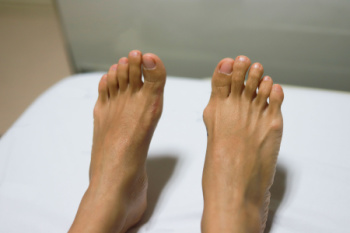
Bunions, also known as hallux valgus, are a type of mechanical foot pain that develop when the big toe shifts out of place over time. This change causes a bony bump to form at the base of the big toe, leading to discomfort and difficulty fitting into regular shoes. The pain is often made worse by standing or walking for long periods, as pressure on the joint increases. Several factors can contribute to bunion development, including inherited foot structure, wearing narrow or tight shoes, and certain foot conditions like flat feet. As the bunion grows larger, it may lead to swelling, stiffness, or even difficulty moving the big toe. Using supportive footwear and wearing custom orthotics can help ease discomfort in the early stages. If the bunion worsens, surgery may be considered. It is suggested you visit a podiatrist to discuss relief and treatment options.
Toe pain can disrupt your daily activities. If you have any concerns, contact the foot specialists of Spartan Podiatry. Our doctors can provide the care you need to keep you pain-free and on your feet.
What Causes Toe Pain?
Most severe toe pain is caused due to a sports injury, trauma from dropping something heavy on the toe, or bumping into something rigid. Other problems can develop over time for various reasons.
Toe pain can be caused by one or more ailments. The most common include:
- Trauma
- Sports injury
- Wearing shoes that are too tight
- Arthritis
- Gout
- Corns and calluses
- Hammertoe
- Bunions
- Blisters
- Ingrown toenails
- Sprains
- Fractures (broken bones)
- Dislocations
When to See a Podiatrist
- Severe pain
- Persistent pain that lasts more than a week
- Signs of infection
- Continued swelling
- Pain that prevents walking
Diagnosis
In many cases the cause of toe pain is obvious, but in others, a podiatrist may want to use more advanced methods to determine the problem. These can range from simple visual inspections and sensation tests to X-rays and MRI scans. Prior medical history, family medical history, and any recent physical traumatic events will all be taken into consideration for a proper diagnosis.
Treatment
Treatments for toe pain and injuries vary and may include shoe inserts, padding, taping, medicines, injections, and in some cases, surgery. If you believe that you have broken a toe, please see a podiatrist as soon as possible.
If you have any questions please feel free to contact our offices located in Battle Creek, and Marshall, MI . We offer the newest diagnostic tools and technology to treat your foot and ankle needs.
Plantar Warts Can Be Treated!
Rock Climbing and Foot Injuries
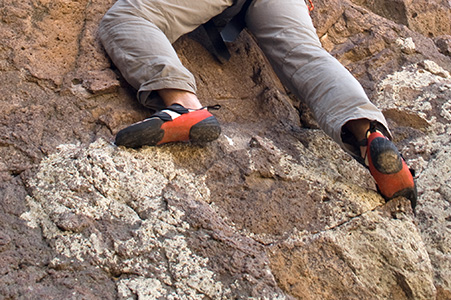
Rock climbers often experience foot injuries due to intense pressure, wearing tight footwear, and repetitive strain. Common injuries include stress fractures, tendonitis, sprains, and bruised toenails. Symptoms can range from sharp pain and swelling to numbness or reduced mobility. Risk factors include poorly fitting climbing shoes, overuse, and inadequate rest between climbs. The unique demands of climbing can lead to chronic foot issues, if not addressed early. A podiatrist can evaluate the injury, recommend supportive footwear, provide targeted treatments, and create a recovery plan to prevent recurrence. If you are a rock climber experiencing persistent foot pain or discomfort, it is suggested that you seek help from a podiatrist to ensure your feet stay strong and ready for your next climb.
Sports related foot and ankle injuries require proper treatment before players can go back to their regular routines. For more information, contact the foot specialists of Spartan Podiatry. Our doctors can provide the care you need to keep you pain-free and on your feet.
Sports Related Foot and Ankle Injuries
Foot and ankle injuries are a common occurrence when it comes to athletes of any sport. While many athletes dismiss the initial aches and pains, the truth is that ignoring potential foot and ankle injuries can lead to serious problems. As athletes continue to place pressure and strain the area further, a mild injury can turn into something as serious as a rupture and may lead to a permanent disability. There are many factors that contribute to sports related foot and ankle injuries, which include failure to warm up properly, not providing support or wearing bad footwear. Common injuries and conditions athletes face, including:
- Plantar Fasciitis
- Achilles Tendinitis
- Achilles Tendon Rupture
- Ankle Sprains
Sports related injuries are commonly treated using the RICE method. This includes rest, applying ice to the injured area, compression and elevating the ankle. More serious sprains and injuries may require surgery, which could include arthroscopic and reconstructive surgery. Rehabilitation and therapy may also be required in order to get any recovering athlete to become fully functional again. Any unusual aches and pains an athlete sustains must be evaluated by a licensed, reputable medical professional.
If you have any questions please feel free to contact our offices located in Battle Creek, and Marshall, MI . We offer the newest diagnostic and treatment technologies for all your foot and ankle needs.
How to Manage Corns on the Feet
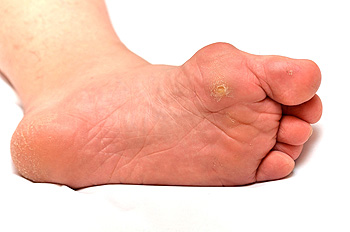
Corns are thickened areas of skin that develop from repeated pressure or friction. They are often caused by wearing ill-fitting shoes, abnormal gait, or underlying foot deformities. Corns typically appear on the top or sides of toes and may look like small, raised bumps with a hard center. While common symptoms include tenderness and discomfort during walking, untreated corns can dig deeper into the skin, causing intense pain, inflammation, and even ulceration, especially in people with diabetes or poor circulation. Some corns may become infected, leading to redness, swelling, and drainage. A podiatrist can accurately diagnose and safely remove corns without risking further damage to the skin. They also address the root cause, whether it is improper footwear, structural imbalances, or walking patterns. Custom orthotics, padding, and footwear advice can help prevent recurrence and relieve pressure points. If you have developed a painful corn, it is suggested that you schedule an appointment with a podiatrist for appropriate relief solutions.
If you have any concerns regarding your feet and ankles, contact the foot specialists of Spartan Podiatry. Our doctors will treat your foot and ankle needs.
Corns: What Are They? and How Do You Get Rid of Them?
Corns can be described as areas of the skin that have thickened to the point of becoming painful or irritating. They are often layers and layers of the skin that have become dry and rough, and are normally smaller than calluses.
Ways to Prevent Corns
There are many ways to get rid of painful corns such as wearing:
- Well-fitting socks
- Comfortable shoes that are not tight around your foot
- Shoes that offer support
Treating Corns
Treatment of corns involves removing the dead skin that has built up in the specific area of the foot. Consult with Our doctors to determine the best treatment option for your case of corns.
If you have any questions please feel free to contact our offices located in Battle Creek, and Marshall, MI . We offer the newest diagnostic and treatment technologies for all your foot and ankle needs.
Ingrown Toenails Are More Than Just a Painful Toe
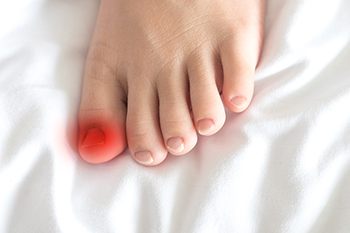
Ingrown toenails occur when the edge of the nail grows into the surrounding skin, causing pain, swelling, and sometimes infection. Common causes include improper trimming like rounding the corners, tight shoes, trauma, or genetic predisposition. While most people know ingrown nails cause pain at the toe’s edge, a lesser-known issue is chronic recurrence, which can lead to thickened skin and nail deformities over time. Symptoms include redness, tenderness, swelling, and sometimes drainage or pus. The area may feel warm and throb with each step, making walking or wearing shoes uncomfortable. Over time, untreated cases can lead to serious infections or skin overgrowth. A podiatrist can diagnose the condition through a simple exam. Treatment ranges from conservative care to partial or full nail removal for persistent cases. Proper nail care education and footwear advice can also help prevent recurrence. If you are dealing with this painful condition, it is suggested that you make an appointment with a podiatrist for evaluation and treatment.
Ingrown toenails can become painful if they are not treated properly. For more information about ingrown toenails, contact the foot specialists of Spartan Podiatry. Our doctors can provide the care you need to keep you pain-free and on your feet.
Ingrown Toenails
Ingrown toenails occur when a toenail grows sideways into the bed of the nail, causing pain, swelling, and possibly infection.
Causes
- Bacterial infections
- Improper nail cutting such as cutting it too short or not straight across
- Trauma to the toe, such as stubbing, which causes the nail to grow back irregularly
- Ill-fitting shoes that bunch the toes too close together
- Genetic predisposition
Prevention
Because ingrown toenails are not something found outside of shoe-wearing cultures, going barefoot as often as possible will decrease the likeliness of developing ingrown toenails. Wearing proper fitting shoes and using proper cutting techniques will also help decrease your risk of developing ingrown toenails.
Treatment
Ingrown toenails are a very treatable foot condition. In minor cases, soaking the affected area in salt or antibacterial soaps will not only help with the ingrown nail itself, but also help prevent any infections from occurring. In more severe cases, surgery is an option. In either case, speaking to your podiatrist about this condition will help you get a better understanding of specific treatment options that are right for you.
If you have any questions please feel free to contact our offices located in Battle Creek, and Marshall, MI . We offer the newest diagnostic and treatment technologies for all your foot and ankle needs.
Common Causes of Heel Pain
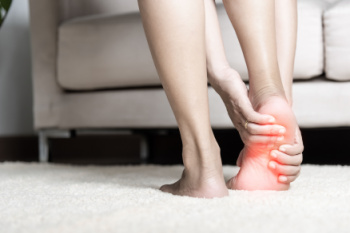
Heel pain often comes from a few common issues in the foot and heel area. One frequent cause of heel pain is plantar fasciitis, which involves micro‑tears in the fibrous band under the foot where it meets the heel bone. Heel spurs can develop as a bone growth at that same connection. Although sometimes symptomless, they can accompany ongoing plantar fascia discomfort. In active adolescent children, Sever’s disease is caused by inflammation of the growth plate at the back of the heel. It typically occurs when their activity level increases or from wearing improper footwear. Wearing tight shoes can cause a so-called pump bump on the back of the heel, which can become painful when walking. A podiatrist can evaluate these sources of heel pain with an exam and imaging tests to determine a treatment plan. If you are experiencing persistent heel pain, it is suggested that you schedule an appointment with a podiatrist for a diagnosis and appropriate treatment.
Many people suffer from bouts of heel pain. For more information, contact the foot specialists of Spartan Podiatry. Our doctors can provide the care you need to keep you pain-free and on your feet.
Causes of Heel Pain
Heel pain is often associated with plantar fasciitis. The plantar fascia is a band of tissues that extends along the bottom of the foot. A rip or tear in this ligament can cause inflammation of the tissue.
Achilles tendonitis is another cause of heel pain. Inflammation of the Achilles tendon will cause pain from fractures and muscle tearing. Lack of flexibility is also another symptom.
Heel spurs are another cause of pain. When the tissues of the plantar fascia undergo a great deal of stress, it can lead to ligament separation from the heel bone, causing heel spurs.
Why Might Heel Pain Occur?
- Wearing ill-fitting shoes
- Wearing non-supportive shoes
- Weight change
- Excessive running
Treatments
Heel pain should be treated as soon as possible for immediate results. Keeping your feet in a stress-free environment will help. If you suffer from Achilles tendonitis or plantar fasciitis, applying ice will reduce the swelling. Stretching before an exercise like running will help the muscles. Using all these tips will help make heel pain a condition of the past.
If you have any questions please contact our offices located in Battle Creek, and Marshall, MI . We offer the newest diagnostic and treatment technologies for all your foot and ankle needs.

